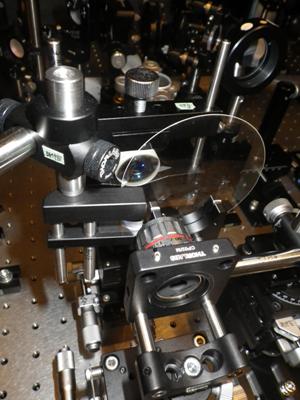Apr 30 2015
When a crystal lattice is excited by a laser pulse, waves of jostling atoms can travel through the material at close to one sixth the speed of light, or approximately 28,000 miles/second. Scientists now have a new tool to take movies of such superfast movement in a single shot.
 Researchers from Japan have developed a new high-speed camera technology, called STAMP, that can record events at a rate of more than 1-trillion-frames-per-second. The prototype camera is shown here in the lab. Credit: Keiichi Nakagawa, University of Tokyo
Researchers from Japan have developed a new high-speed camera technology, called STAMP, that can record events at a rate of more than 1-trillion-frames-per-second. The prototype camera is shown here in the lab. Credit: Keiichi Nakagawa, University of Tokyo
Researchers from Japan have developed a new high-speed camera that can record events at a rate of more than 1-trillion-frames-per-second. That speed is more than one thousand times faster than conventional high-speed cameras. Called STAMP, for Sequentially Timed All-optical Mapping Photography, the new camera technology "holds great promise for studying a diverse range of previously unexplored complex ultrafast phenomena," said Keiichi Nakagawa, a research fellow at the University of Tokyo, who worked to develop the camera with colleagues from an array of Japanese research institutions.
Conventional high-speed cameras are limited by the processing speed of their mechanical and electrical components. STAMP overcomes these limitations by using only fast, optical components.
Another optical imaging technique, called the pump-probe method, can create movies with an even higher frame rate than STAMP, but can only capture one frame at a time -- limiting its use to processes that are exactly reproducible.
"Many physical and biological phenomena are difficult to reproduce," said Nakagawa. "This inspired me to work on an ultrafast camera that could take multiple frames in a single shot."
Nakagawa himself experienced the need for such a camera while he was a master's student studying how acoustic shock waves changed living cells. Scientists believe mechanical stress, like that caused by acoustic waves, might increase bone and blood vessel growth, but they had no tools for capturing the dynamics of such a fast, transient event as a shock wave passing through a cell.
"Since there was no suitable technique, I decided to develop a new high-speed imaging technique in my doctoral program," Nakagawa said.
STAMP relies on a property of light called dispersion that can be observed in the way a misty sky splits sunshine into a rainbow of colors. Similarly, STAMP splits an ultrashort pulse of light into a barrage of different colored flashes that hit the imaged object in rapid-fire succession. Each separate color flash can then be analyzed to string together a moving picture of what the object looked like over the time it took the dispersed light pulse to travel through the device.
In the first iteration of STAMP, which the team described in a paper published in Nature Photonics in August 2014, the number of frames that the camera could take in a single shot was limited to six.
Currently, the team is constructing an improved STAMP system that can acquire 25 sequential images. Nakagawa believes the number of frames could eventually be increased to 100 with current technology.
Nakagawa notes that because STAMP operates on the assumption that all the differently colored daughter pulses interact with the imaged object in the same way, the camera should not be used to image samples whose optical properties change over the range of wavelengths STAMP uses.
Even given STAMP's limitations, the technology has enormous potential, Nakagawa says. His team has already used it with image electronic motion and lattice vibrations in a crystal of lithium niobate and to observe how a laser focused onto a glass plate creates a hot, rapidly expanding plume of plasma.
Nakagawa notes that the camera could be used to explore a wide range of ultrafast phenomena for the first time, including the laser ignition of fusion, the phase transition of materials, and the dynamics of a Coulomb explosion, an event in which intense electromagnetic fields (for example from a narrow laser beam) can force a small amount of solid material to explode into a hot plasma of ionized atomic particles.
"I think it is important to note that there might be many potential applications of STAMP that I have not imagined," Nakagawa said. "I hope more researchers will become interested in STAMP."